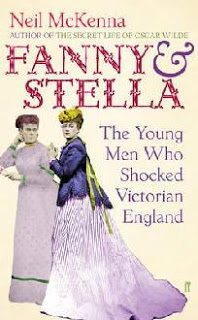The writer and raconteur Quentin Crisp is credited by many with paving the way for homosexuals in late 1920s and early 30s in London through his outlandish behaviour and dress sense. Crisp hung out in Soho’s cafes, meeting other homosexuals and rent-boys and experimenting with make-up and with women’s clothes.
He wore bright make-up, dyed his long hair red, painted his fingernails and wore sandals to display his painted toe-nails, braving derisory comments and violence just so he could be as he wished. Crisp spent three decades as a life model for artists before capturing his own colourful life in his memoir, The Naked Civil Servant, written in 1968.
But hold on a minute, before we all start basking in the warm pink glow that was Quentin’s life, let’s not forget the real trail blazers when it came to cross-dressing – although you’ll need to look as far back as 1870 to find them.
A new book by writer Neil McKenna, entitled Fanny & Stella (published by Faber & Faber), captures the extraordinary lives of two Victorian gentlemen who found infamy at the time due to their fondness for cross-dressing.
Frederick Park (22) and Ernest Boulton (21) made the headlines in a spectacular fashion on April 28, 1870 when they were arrested and charged with the ‘unnatural offence’ of being transvestites.
The scandal emerged when policemen arrested two glamorous women as they exited The Strand Theatre in London. It turned out that the two had spent most of the evening flirting with a variety of men in the audience. But the real shock came when onlookers heard the police officer from Bow Street state that he had reason to believe that the ‘women’ were, in fact, men.
The transvestites, Fanny and Stella turned out to be two middle-class gentlemen with a liking for cross-dressing – and their subsequent court trial for being transvestites and for allegedly having sex with each other scandalised Victorian England.
The police were obviously pretty keen to make these charges stick. They had kept the men’s ‘dressing-up flat’ under surveillance for a year – and the Home Secretary of the day was encouraging the Attorney General to prosecute.
Frederick was the elder of the two, and the son of Judge Alexander Park. His brother, Harry, had already left England and fled to Scotland after being arrested for homosexual offences. Ernest, just 20 at the time, was the son of a shipping broker, and worked as a banker.
The case went to trial in May 1871. It was a showcase affair with the Lord Chief Justice as judge and the prosecution led by the Attorney-General, assisted by the Solicitor-General. If convicted, the men faced ten years in prison.
Despite all the heavy legal hitters, the trial failed and the men were acquitted. Boulton’s case was helped by his mother, Mary Ann, who testified to say that it was no secret her son’s nickname was ‘Stella’ and that he enjoyed dressing as a woman. Her candid remarks made the case look more silly than sordid.
After the trial, Frederick Park joined his brother Harry in America, and died in New Jersey in 1881. Ernest Boulton changed his name to Ernest Byne and toured as a female impersonator with his brother Gerard. He died in England in 1903…. five years before Quentin Crisp even breathed his first gasp of air.




You find the most interesting stories, David! The bravery these men displayed is amazing.
LikeLike
Thanks Carol. Yes, it took a lot of guts to do what they did. Brave souls indeed…
LikeLike
Crossdressing interests me. I’ve written two historical novels about a crossdressing woman in the 18th century. http://www.amazon.com/Barbados-Patricia-McPherson-Adventure-ebook/dp/B008PHZBS6/ref=sr_1_1?s=digital-text&ie=UTF8&qid=1361334209&sr=1-1&keywords=barbados+bound Love to read about crossdressing men, too.
LikeLike
Thanks Linda, your book, Barbados Bound is certainly one that looks like an interesting read.
LikeLike
Fascinating stuff.
Check this link out Dave for some interesting historical cross-dressers http://library.transgenderzone.com/?page_id=1176.
I particularly like ‘Rebecca and her daughters’ a group of men in the 1830s who went about destroying road toll barriers. Now there is a constructive idea!
As for women dressing as men – George Sand of course, and I have just read a novel about Pope Joan who pretended to be a man to get to be Pope, allegedly if myth be true.
LikeLike
That’s a great list, Conor. Just shows how far back such behaviour goes. You’re rright, the ‘Rebeccas’ were a force to be reckoned with. By the way, I replied to en email from you but there seems to be a problem with your address. Text me when you want to meet up before you head off to the wilds of Saudi.
LikeLike
Another interesting post! The cross-dressing men often looked prettier than the women of that era!
LikeLike
I’ll take your word for that!
LikeLike
Outstanding article. As a man that enjoys dressing as a women I have read about these two many years ago. It is good to see that they have not been forgotten.
LikeLike
Thanks very much, I’m glad you enjoyed it.
LikeLike
Pingback: The Extraordinary Case of the Cross-dressing Victorians – A Crossdressing Tapestry